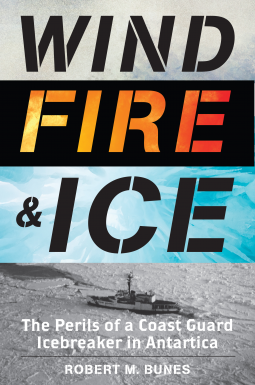Please wait... This may take a moment.
Wind, Fire, and Ice
The Perils of a Coast Guard Icebreaker in Antarctica
This title was previously available on NetGalley and is now archived.
Pub Date
Oct 01 2021
| Archive Date
Oct 08 2021
Description
Between 1955 and 1987, the United States Coast Guard Cutter Glacier was the largest and most powerful icebreaker in the free world. Consequently, it was often given the most difficult and dangerous Antarctic missions. This is the dramatic first-person account of its most legendary voyage. In 1970, the author was the Chief Medical Officer on the Glacier when it became trapped deep in the Weddell Sea, pressured by 100 miles of wind-blown icepack. Glacier was beset within seventy miles of where Sir Ernest Shackleton’s ship, the Endurance, was imprisoned in 1915. His stout wooden ship succumbed to the crushing pressure of the infamous Weddell Sea pack ice and sank, leading to an unbelievable two-year saga of hardship, heroism and survival. The sailors aboard the Glacier feared they would suffer Shackleton’s fate, or one even worse. Freakishly good luck eventually saved the Glacier from destruction, but the story is told as the author, who was not part of the chain of command, experienced it. More imminent threats later occurred involving a three-hour inferno, as well as eight-story waves that drove the ship to the brink of disaster. Wind, Fire, and Ice is the story about a physician fresh-out-of-internship who naïvely assumes he is going to have an easy assignment and see numerous exotic ports. Instead, he experiences adventures and adversities beyond his imagination, as well as jarring conflicts with an obsessed captain.
Between 1955 and 1987, the United States Coast Guard Cutter Glacier was the largest and most powerful icebreaker in the free world. Consequently, it was often given the most difficult and dangerous...
Description
Between 1955 and 1987, the United States Coast Guard Cutter Glacier was the largest and most powerful icebreaker in the free world. Consequently, it was often given the most difficult and dangerous Antarctic missions. This is the dramatic first-person account of its most legendary voyage. In 1970, the author was the Chief Medical Officer on the Glacier when it became trapped deep in the Weddell Sea, pressured by 100 miles of wind-blown icepack. Glacier was beset within seventy miles of where Sir Ernest Shackleton’s ship, the Endurance, was imprisoned in 1915. His stout wooden ship succumbed to the crushing pressure of the infamous Weddell Sea pack ice and sank, leading to an unbelievable two-year saga of hardship, heroism and survival. The sailors aboard the Glacier feared they would suffer Shackleton’s fate, or one even worse. Freakishly good luck eventually saved the Glacier from destruction, but the story is told as the author, who was not part of the chain of command, experienced it. More imminent threats later occurred involving a three-hour inferno, as well as eight-story waves that drove the ship to the brink of disaster. Wind, Fire, and Ice is the story about a physician fresh-out-of-internship who naïvely assumes he is going to have an easy assignment and see numerous exotic ports. Instead, he experiences adventures and adversities beyond his imagination, as well as jarring conflicts with an obsessed captain.
Available Editions
| EDITION |
Other Format |
| ISBN |
9781493060344 |
| PRICE |
$32.95 (USD)
|
Additional Information
Available Editions
| EDITION |
Other Format |
| ISBN |
9781493060344 |
| PRICE |
$32.95 (USD)
|
Average rating from 5 members
Featured Reviews
 Erich H, Reviewer
Erich H, Reviewer
5 stars
5 stars
5 stars
5 stars
5 stars
Dr. Robert M. Bunes volunteered to serve on an ice breaker (called the Glacier) headed to Antarctica in the U.S. Coast Guard at the height of the Vietnam War. Bunes explains he didn’t agree with the war, but he also wanted to serve his country. The Public Health Service offered a way to serve without having to serve directly in Vietnam.
He joins the Coast Guard as a way to avoid fighting in Vietnam without acting with cowardice, but he soon discovers so many great things accompanying Coast Guard service—a sense of pride in serving a branch that has rescued more than one million people (according to Coast Guard historians), fellow service members who share his mission to save lives, even some whom become personal friends, and better pay than being a medical intern. Readers quickly learn it takes a brave individual to serve on an ice breaker headed to Antarctica.
This is a memoir—most readers will already know this—so, if you are expecting a clinical approach, your expectations might be dashed. However, I really enjoyed the conversational style of the writing. I really felt like I was there with Bunes, his boss Captain Brennan, and the uptight chief who loves crew cuts and hates Bunes’ mustache. Bunes includes photos and maps as visual aids (it’s really helpful when he is describing the specifics of Antarctica).
I really enjoyed how Bunes uses Ernest Shackleton as a comparison to his predicament. Of course, Shackleton and his crew were heroes for their explorations and brave survival in frigid conditions in Antarctica, but, while Bunes and his crew aren’t afforded the same reverence and don’t experience the same conditions, they do have to demonstrate similar traits, particularly perseverance as they face multiple obstacles. Overall, a great read. Thanks to the author, Rowman & Littlefield and NetGalley for the ARC.
5 stars
5 stars
5 stars
5 stars
5 stars
Readers who liked this book also liked:
Five
Ilona Bannister
General Fiction (Adult), Mystery & Thrillers
Pendergast
Douglas Preston; Lincoln Child
General Fiction (Adult), Mystery & Thrillers
Jigsaw
Jonathan Kellerman
General Fiction (Adult), Mystery & Thrillers
Winter
Val McDermid
Biographies & Memoirs, Essays & Collections, Outdoors & Nature
Carlo Gambino
Frank Dimatteo; Michael Benson
Biographies & Memoirs, History, True Crime
Butler
Salena Zito
History, Politics & Current Affairs



















